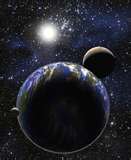Solar System: Science Knowledge Quiz!
.webp)
Explore the wonders of our Solar System with this engaging quiz! Test your knowledge on asteroids, stars, comets, terrestrial planets, moons, and orbital mechanics. This quiz is perfect for learners curious about celestial bodies and their dynamics.
- 1.
An Asteroid is
- A.
Very large obects that orbit a star
- B.
Bodies in outer space, made of hot gases, that shine in the night sky
- C.
Irregularly shaped rocks that orbit the Sun
Correct Answer
C. Irregularly shaped rocks that orbit the SunExplanation
An asteroid is an irregularly shaped rock that orbits the Sun. This means that it is not a very large object that orbits a star, nor is it a body in outer space made of hot gases that shine in the night sky. Instead, it is a rocky object that varies in shape and size and orbits around the Sun.Rate this question:
-
- 2.
A star is a body in outer space, made of hot gases, that shine in the night sky.
- A.
True
- B.
False
Correct Answer
A. TrueExplanation
A star is indeed a body in outer space that is made up of hot gases and emits light, which is why it shines in the night sky. Stars are formed through the process of nuclear fusion, where immense pressure and temperature cause hydrogen atoms to combine and release energy in the form of light and heat. This explanation aligns with the definition of a star and its characteristics.Rate this question:
-
- 3.
Comets are space objects made of ice and
Correct Answer
dust, tiny stars, dwarfs - 4.
A Terrestial is
- A.
Like Earth
- B.
Like Mars
- C.
Like Venus
Correct Answer
A. Like EarthExplanation
A terrestrial is like Earth because it refers to any object or phenomenon that is related to or characteristic of the Earth. This term is commonly used to describe planets or celestial bodies that are similar to Earth in terms of composition, structure, or conditions that support life. Therefore, a terrestrial can be understood as something that shares similarities with Earth in various aspects.Rate this question:
-
- 5.
Moons are huge balls of rock that travel around a planet.
- A.
True
- B.
False
Correct Answer
A. TrueExplanation
Moons are indeed large celestial bodies made of rock that orbit around planets. They are held in place by the gravitational force of the planet they orbit. Examples of moons in our solar system include Earth's moon, Titan (Saturn's moon), and Ganymede (Jupiter's moon).Rate this question:
-
- 6.
Orbiting is the same as
Correct Answer
revolving
revolving around
revolving around another objectExplanation
The correct answer is revolving, revolving around, revolving around another object. Orbiting refers to the motion of an object around another object, typically due to gravitational force. This motion is characterized by a continuous revolution or rotation around a central point or axis. Therefore, the terms revolving, revolving around, and revolving around another object accurately describe the concept of orbiting.Rate this question:
- 7.
Gravity is
- A.
The force of nature
- B.
The force that pulls all objects toward each other
- C.
Astronauts in space
Correct Answer
B. The force that pulls all objects toward each otherExplanation
Gravity is the force that pulls all objects toward each other. This force is responsible for the attraction between all objects with mass. It is what keeps us grounded on Earth and determines the motion of planets, stars, and galaxies. Gravity is a fundamental force of nature that governs the behavior of objects on a large scale.Rate this question:
-
- 8.
Planets are
- A.
Very small objects that orbit a star
- B.
Very large objects that orbit the sun
- C.
Very larg objects that orbit a star
Correct Answer
C. Very larg objects that orbit a starExplanation
Planets are very large objects that orbit a star. This is because planets are celestial bodies that are much larger than other objects in space, such as asteroids or comets. Additionally, planets orbit a star, usually the sun, in a regular and predictable manner. Therefore, the correct answer is "very large objects that orbit a star."Rate this question:
-
- 9.
Gas giants are
- A.
Large planets that are made up of gases
- B.
Large planets that are made up of stars
- C.
Large planets that are made up of moons
Correct Answer
A. Large planets that are made up of gasesExplanation
Gas giants are large planets that are primarily composed of gases such as hydrogen and helium. Unlike rocky planets, gas giants do not have a solid surface and instead have thick atmospheres that extend deep into their interiors. These planets are predominantly made up of hydrogen and helium, with traces of other elements. Gas giants are known for their massive size and strong gravitational pull, and they are often found in the outer regions of a planetary system.Rate this question:
-
Quiz Review Timeline +
Our quizzes are rigorously reviewed, monitored and continuously updated by our expert board to maintain accuracy, relevance, and timeliness.
-
Current Version
-
Sep 11, 2024Quiz Edited by
ProProfs Editorial Team -
Nov 03, 2010Quiz Created by
Mruggiero
 Back to top
Back to top



